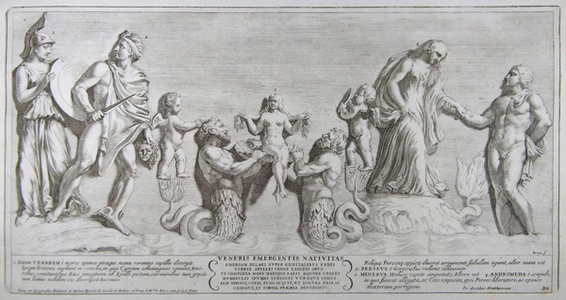| Method | Etching |
| Artist | Pietro Santi Bartoli |
| Published | Romæ ex Typographia Domenici de Rubeis Hæredis Io. Iacobi de Rubeis ad Temp. S. Mæ. de Pace cum Priv. S. Pont. [1693] |
| Dimensions | Image 220 x 430 mm, Plate 223 x 432 mm, Sheet 362 x 472 mm |
| Notes |
A depiction of a Roman relief sculpture of the birth of Venus, and the myth of Perseus, Plate 30 from Bartoli's Admiranda Romanarum Antiquitatum (1693). At the time of publication the relief was part of the collections of the powerful Mattei family at the Villa Celimontana in Rome, and likely came from excavations on or near the Caelian Hill. The frieze depicts three separate mythological events. In the centre, the goddess Venus is born from the sea, sitting on a scallop shell and held aloft by a pair of fish-tailed tritons. A pair of winged cupids float nearby, resting on the tails of the tritons. To the left of this scene, the goddess Minerva holds the polished bronze shield that Perseus has just used as a mirror to escape the deadly gaze of the snake-haired medusa. Perseus, with the wings of Hermes at his ankles, holds the head of Medusa in one hand, and his dagger in the other. On the right of the scene, Andromeda, daughter of king Cepheus of Libya, is helped down from a rock by Perseus. The tail of Cetus, a sea-monster Perseus killed to save Andromeda, can be seen in the background. The ocean seems to be the strongest linking device between these two separate mythological stories. In most versions of the birth of Venus, she is created from the sea-foam when the genitals of the sky-god Uranus are severed and thrown into the sea by Cronus. Her Greek name, Aphrodite, is often described as deriving from the word for foam, aphros. Her birth was usually connected with the sea coasts of her major cult-centres, on the islands of Cyprus and Cythera, and has been a popular motif in art since the classical period. The famous painting by Botticelli follows a tradition that goes back to at least the fourth century BC, when the great artist Apelles painted the goddess appearing from the sea naked and fully grown on a scallop shell. The myth of the Aethiopian virgin Andromeda, by contrast, occurs on the sea coast of northern Africa. Andromeda's mother had foolishly boasted that her daughters were as beautiful as the Nereids, the sea-nymphs. Poseidon, god of the sea, took umbrage with the comparison and sent a sea-monster to terrorise the coasts of the kingdom, and would only be satisfied by Andromeda's sacrifice. Luckily for the young woman, the hero Perseus was passing on his return from having slain Medusa, and having killed the sea-monster, married Andromeda and took her back to Greece, where together they founded the city of Mycenae. The Admiranda Romanarum Antiquitatum ac Veteris Sculpturae Vestigia Anaglyphico Opere Elaborata ex Marmoreis Exemplaribus was one of a number of illustrated volumes on antiquarian subjects published by the prolific de Rossi family. The work featured 83 etched plates by the antiquarian and engraver, Pietro Santi Bartoli, depicting examples of Roman relief sculpture, all of which Bartoli had viewed and studied in the various papal and aristocratic collections across Rome. Like many of Bartoli's works, the plates of the Admiranda Romanarum Antiquitatum included commentary and notes by the celebrated antiquarian, Giovanni Pietro Bellori, with whom Bartoli enjoyed a long and fruitful academic partnership. The work was dedicated by the publishers to Cardinal Flavio Chigi, nephew of Pope Alexander VII and a member of the powerful Chigi family, who had died in September 1693, the same year as its publication. Cardinal Chigi had been a close friend of Bartoli's patron, Queen Christina of Sweden. His position in such a powerful papal family had also been beneficial to engravers and publishers, particularly those with an interest in classical architecture. Alexander VII had been one of the great 'builder' popes, whose term had endowed Rome with numerous churches, public fountains, gardens, and palazzi in the rococo style, as well as encouraging the excavation, documentation, and in some cases, restoration, of the monuments of the classical era. Many of the relief sculptures depicted in the Admiranda Romanarum Antiquitatum had been rediscovered in these excavations, and were quickly added to the collections of the Chigi family and their peers. Pietro Santi Bartoli (1635 – 7th November 1700) was an Italian draughtsman, architect, antiquarian, and engraver. Born in Perugia, Bartoli apprenticed with Jean Lemaire and Nicholas Poussin. Although he would give up painting following Poussin's death to focus on engraving, the classical scenes that were the speciality of Poussin and Lemaire were probably responsible for the young Bartoli's interest in classical subjects. In collaboration with the antiquarian Bellori and the publishers Giovanni and Domenico de Rossi, Bartoli produced a number of works documenting the art, architecture, history, and culture of ancient Rome. Of particular note are his series of 128 etchings depicting details of the frieze on the Column of Trajan, and a number of plates of Roman monuments after Giacomo Lauro that were published by Domenico de Rossi in his Romanae Magnitudinis Monumenta in 1699. Condition: Encircled fleur-de-lis watermark. Minor time toning to edges of sheets. Minor creasing to corners of sheets, not affecting plate or image. |
| Framing | unmounted |
| Price | £75.00 |
| Stock ID | 40671 |

